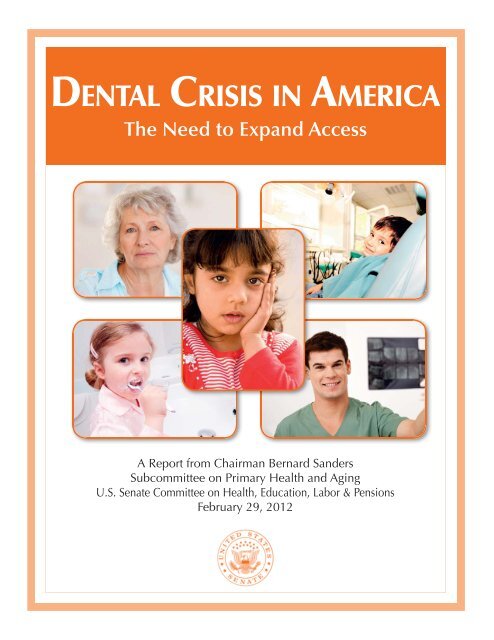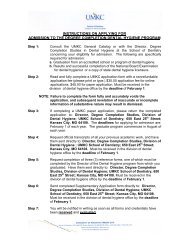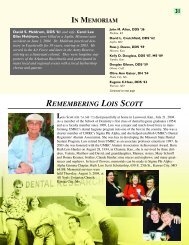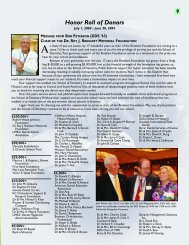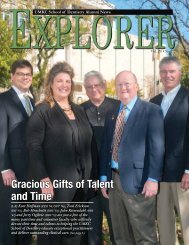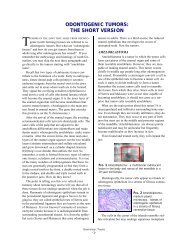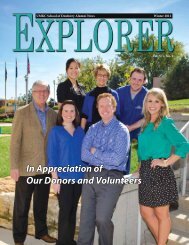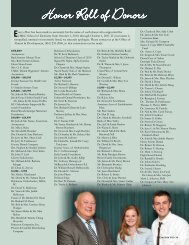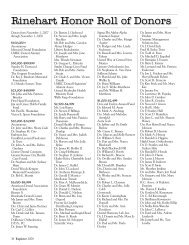"Dental Crisis in America" (pdf) - Senator Bernie Sanders - U.S. Senate
"Dental Crisis in America" (pdf) - Senator Bernie Sanders - U.S. Senate
"Dental Crisis in America" (pdf) - Senator Bernie Sanders - U.S. Senate
You also want an ePaper? Increase the reach of your titles
YUMPU automatically turns print PDFs into web optimized ePapers that Google loves.
KEY FINDINGSMore than 47 million peoplelive <strong>in</strong> places where it is difficultto access dental care. 1About 17 million low-<strong>in</strong>comechildren received no dental care<strong>in</strong> 2009. 2One fourth of adults <strong>in</strong> the U.S.ages 65 and older have lost allof their teeth. 3Low-<strong>in</strong>come adults are almosttwice as likely as higher-<strong>in</strong>comeadults to have gone without adental check up <strong>in</strong> the previousyear. 4Bad dental health impacts overallhealth and <strong>in</strong>creases the riskfor diabetes, heart disease, andpoor birth outcomes. 5There were over 830,000 visitsto emergency rooms across thecountry for preventable dentalconditions <strong>in</strong> 2009 - a 16%<strong>in</strong>crease s<strong>in</strong>ce 2006. 6Almost 60% of kids ages 5 to17 have cavities - mak<strong>in</strong>g toothdecay five times more commonthan asthma among children ofthis age. 7Nearly 9,500 new dental providersare needed to meet thecountry’s current oral healthneeds. 8However, there are more dentistsretir<strong>in</strong>g each year than thereare dental school graduates toreplace them. 9INTRODUCTIONIn the U.S., many people have access to the best oralhealth care <strong>in</strong> the world, yet millions are unable toget even the basic dental care they need. Individualswho are low-<strong>in</strong>come or racial or ethnic m<strong>in</strong>orities,pregnant women, older adults, those with specialneeds, and those who live <strong>in</strong> rural communities oftenhave a much harder time access<strong>in</strong>g a dental providerthan other groups of Americans. Tooth decay isalmost completely preventable, yet when people donot see a dental provider, they do not get the preventiveservices and early diagnosis and <strong>in</strong>terventionsthat can halt or slow the progress of most oral diseases.The issue of lack of access to dental care is extremelyserious because untreated oral diseases canlead to not only pa<strong>in</strong>, <strong>in</strong>fection, and tooth loss, butalso contribute to an <strong>in</strong>creased risk for serious medicalconditions such as diabetes, heart disease, andpoor birth outcomes. 10S<strong>in</strong>ce 2000, when the U.S. Surgeon General calleddental disease a “silent epidemic,” 11 there has been<strong>in</strong>creas<strong>in</strong>g attention paid to oral health issues.“Healthy People 2020,” a report issued every decadeby the Department of Health and Human Servicesreleased <strong>in</strong> December 2010, <strong>in</strong>cludes oral health asa lead<strong>in</strong>g health <strong>in</strong>dicator for the first time, and theInstitute of Medic<strong>in</strong>e published two reports <strong>in</strong> 2011which illustrated that the lack of access to neededcare and oral health disparities cont<strong>in</strong>ue to be hugeproblems for millions of people. However, not nearlyenough has been done to adequately address thetrue oral health crisis that exists <strong>in</strong> America today.1
THE PROBLEM: MANYAMERICANS CANNOT GETTHE ORAL HEALTH CARETHEY NEEDThose Who Need Care the Most arethe Least Likely to Get ItOral health problems affect people of all ages andbackgrounds. For many, oral health problems startwhen they are young and get worse over time. Onequarter of children ages 2-5 and one half of those12-15 have tooth decay. In fact, dental caries (cavities)are the most common chronic disease of childhoodaffect<strong>in</strong>g almost 60% of children ages 5 to 17.As people grow older they cont<strong>in</strong>ue to be plaguedby oral health problems. One <strong>in</strong> four adults ages 65and older <strong>in</strong> the U.S. have lost all of their teeth. 12While there are high rates of oral disease <strong>in</strong> allage groups, low-<strong>in</strong>come Americans of any age aremore likely than higher-<strong>in</strong>come Americans to haveoral health problems. Lack of access to a dentalprovider and the high costs of dental services area major cause of these dental problems. About 17million low-<strong>in</strong>come children go each year withoutbasic care that could prevent the need for highercost treatment later on. 13 Children liv<strong>in</strong>g below thepoverty l<strong>in</strong>e are twice as likely as their more affluentpeers to suffer from toothaches, and the likelihoodof experienc<strong>in</strong>g this pa<strong>in</strong> is even greater for kidswith special needs. 14 In Vermont <strong>in</strong> 2009, 62,000adults ages 18 to 64 and 10,000 seniors went withoutdental care because they could not afford it. 15Some racial and ethnic m<strong>in</strong>ority groups have evenhigher rates of oral health conditions. American Indianand Alaska Natives have the highest rates ofdental disease, and rates of untreated decay arealso significantly higher among Mexican Americansand African Americans than among those who areWhite. 16 People from m<strong>in</strong>ority groups are underrepresented<strong>in</strong> the dental profession although they are<strong>in</strong> greater need of care.In addition to the high costs of care, low-<strong>in</strong>comeand m<strong>in</strong>ority families may experience other barriersto care <strong>in</strong>clud<strong>in</strong>g language and cultural barriers,transportation challenges, and difficulty f<strong>in</strong>d<strong>in</strong>gwork and childcare arrangements. See<strong>in</strong>g a dentistis expensive, so many people seek care only whenthe disease is advanced and the pa<strong>in</strong> is unbearable.It is at that po<strong>in</strong>t when many people go to the emergencyroom for relief because they have no otheroption. To makematters worse,often people arefaced with thedifficult decisionto remove theirteeth because extractionsare considerablycheaperthan the cost oftreatments to savethem, regardlessof the negativehealth and socialimpacts of miss<strong>in</strong>gteeth.Heather Getty, East Fairfield, Vermont: “My husband and I and our four kids are the work<strong>in</strong>g poor.We have to th<strong>in</strong>k about rent and electricity before we th<strong>in</strong>k about dental care. My wisdom teethhave been a problem for over a decade now. I take ibuprofen and just keep on go<strong>in</strong>g. My husbandhas not seen a dentist s<strong>in</strong>ce he was a teenager. He’s afraid of the costs if they f<strong>in</strong>d someth<strong>in</strong>g. So it’sbeen 20 years. Because of Vermont’s Dr. Dynasaur program, at least my children have been luckyenough to have regular clean<strong>in</strong>gs, but I have to comb through the Yellow Pages to f<strong>in</strong>d an officewho will accept their coverage. One time I missed an appo<strong>in</strong>tment because my car broke down,and when I called to reschedule, they told me that we had been blacklisted and that no one frommy family could be seen by that office aga<strong>in</strong>. We’ve learned over the years how important dentalcare is. If you get preventive care early, you are less likely to have problems later on.”2
REFERENCES1Health Resources and Services Adm<strong>in</strong>istration [HRSA]. Shortage Designation: Health ProfessionalShortage Areas and Medically Underserved Areas/Populations. Accessed February 7, 2012, fromhttp://bhpr.hrsa.gov/shortage/2Pew Center on the States [Pew].The Cost of Delay: State <strong>Dental</strong> Policies Fail One <strong>in</strong> Five Children;February 2010. http://www.pewtrusts.org/uploadedFiles/Cost_of_Delay_web.<strong>pdf</strong>3Centers for Disease Control and Prevention [CDC]. Oral Health: Prevent<strong>in</strong>g Cavities, Gum Disease,Tooth Loss, and Oral Cancers; 2011. http://www.cdc.gov/chronicdisease/resources/publications/aag/<strong>pdf</strong>/2011/Oral-Health-AAG-PDF-508.<strong>pdf</strong>4Haley J et al. “Access to Affordable <strong>Dental</strong> Care: Gaps for Low-Income Adults.” Kaiser Low IncomeCoverage and Access Survey; July 2008. http://www.kff.org/medicaid/upload/7798.<strong>pdf</strong>5Institute of Medic<strong>in</strong>e [IOM]. Advanc<strong>in</strong>g Oral Health <strong>in</strong> America; 2011. http://www.hrsa.gov/publichealth/cl<strong>in</strong>ical/oralhealth/advanc<strong>in</strong>goralhealth.<strong>pdf</strong>6Pew. A Costly <strong>Dental</strong> Dest<strong>in</strong>ation: Hospital Care Means States Pay Dearly; February 2012. http://www.pewcenteronthestates.org/dental7U.S. Department of Health and Human Services [DHHS]. Oral Health <strong>in</strong> America. A Report of theSurgeon General; 2000, p. 63. http://silk.nih.gov/public/hck1ocv.@www.surgeon.fullrpt.<strong>pdf</strong>8HRSA. Shortage Designation. See note 1.9Beazoglou T et al. “Sell<strong>in</strong>g Your Practice at Retirement.” Journal of the American <strong>Dental</strong> Association,Vol. 131, No. 12, 1693-1698; 2000. See also Gehshan S et al. Help Wanted: A Policy Maker’sGuide to New <strong>Dental</strong> Providers; May 2009. http://www.pewcenteronthestates.org/uploadedFiles/<strong>Dental</strong>_Report_Help_Wanted.<strong>pdf</strong>10DHHS. Oral Health <strong>in</strong> America. See note 7.11DHHS. Oral Health <strong>in</strong> America. p. vii. See note 7.12CDC. Oral Health. See note 3.13Pew. The Cost of Delay. See note 2.14Lewis C and Stout J. “Toothache <strong>in</strong> U.S. Children.” Archives of Pediatric Adolescent Medic<strong>in</strong>e, Vol.161, No. 11, 1059-1063; 2010.15F<strong>in</strong>n C. Vermont Oral Health Care for All Project; 2000. http://www.newenglandruralhealth.org/activities/items/oralhealth/pres-11/F<strong>in</strong>n_2011.<strong>pdf</strong> Derived from 2009 Vermont Household HealthInsurance Survey: Comprehensive Report. http://www.bishca.state.vt.us/sites/default/files/VH-HIS-2009.<strong>pdf</strong>16CDC. Disparities <strong>in</strong> Oral Health. Accessed February 8, 2012 from http://www.cdc.gov/oralhealth/oral_health_disparities.htm8
33Fox K. “Special Report: An In-Depth Look at New <strong>Dental</strong> Schools.” ADA News; September 2011.Accessed February 8, 2012, from http://www.ada.org/news/6173.aspx34IOM. Improv<strong>in</strong>g Access to Oral Health Care for Vulnerable and Underserved Populations; 2011, p.7. http://www.iom.edu/Reports/2011/Improv<strong>in</strong>g-Access-to-Oral-Health-Care-for-Vulnerable-and-Underserved-Populations.aspx35Nash DA et al. “<strong>Dental</strong> Therapists: A Global Perspective.” International <strong>Dental</strong> Journal, Vol. 58, No.2, 61-70; 2008.36Nash. “<strong>Dental</strong> Therapists.” See note 35.37Wetterhall S et al. Evaluation of the <strong>Dental</strong> Health Aide Therapist Workforce Model <strong>in</strong> Alaska;October 2010. Accessed January 12, 2012 from http://www.wkkf.org/knowledge-center/resources/2010/10/Alaska-<strong>Dental</strong>-Therapist-Program-RTI-Evaluation-Report.aspx38Pew. It Takes a Team: How New <strong>Dental</strong> Providers Can Benefit Patients and Practices; December2010. http://www.pewcenteronthestates.org/uploadedFiles/Pew_It_Takes_a_Team.<strong>pdf</strong>39Hanlon C. Reimburs<strong>in</strong>g Medical Providers for Preventive Oral Health Services: State Policy Options;February 2010. http://nashp.org/sites/default/files/Pew%20Oral%20Health.<strong>pdf</strong>?q=files/Pew%20Oral%20Health.<strong>pdf</strong>40Pew. It Takes a Team. See note 38.41KFF. “State Health Facts.” Number of federally-funded federally qualified health centers,2010. Accessed February 9, 2012 from http://www.statehealthfacts.org/comparemaptable.jsp?cat=8&<strong>in</strong>d=424.42IOM. Improv<strong>in</strong>g Access to Oral Health Care for Vulnerable and Underserved Populations. See note 34.43HRSA. School-Based Health Centers. Accessed February 8, 2012 from http://www.hrsa.gov/ourstories/schoolhealthcenters/44IOM. Improv<strong>in</strong>g Access to Oral Health Care for Vulnerable and Underserved Populations. See note 34.45National Maternal and Child Oral Health Policy Center. Oral Health Opportunities <strong>in</strong> School-Based Health Centers; October 2010. http://nmcohpc.net/resources/SBHC%20Issue%20Brief%20F<strong>in</strong>al.<strong>pdf</strong>46Pew. The Cost of Delay. See note 2.47Decker SL. “Medicaid Payment Levels to Dentists and Access to <strong>Dental</strong> Care Among Children andAdolescents.” Journal of the American Medical Association, Vol. 306, No. 2, 187-193; 2011.48CDC. “Ten Great Public Health Achievements—United States, 1900-1999.” Morbidity and MortalityWeekly Report, Vol. 48, No. 12, 241; April 2, 1999.49Pew. The Cost of Delay. See note 2.50DHHS. Oral Health <strong>in</strong> America. p. vii. See note 7.10
129574


